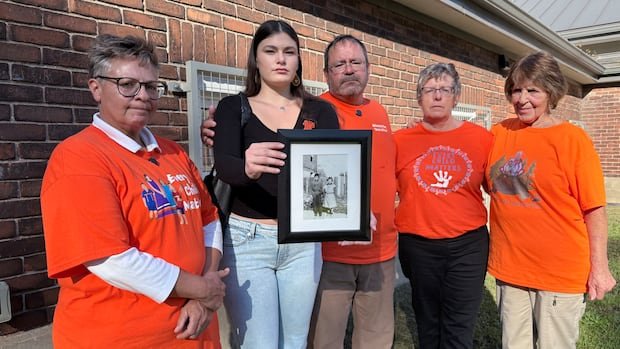The Woodland Cultural Centre in Brantford, Ontario, unveiled its new museum on the National Day for Truth and Reconciliation, marking the transformation of Canada’s former longest-running residential school into a space celebrating Indigenous language, culture, art, and history. Attendees expressed various reasons for visiting the museum, from learning about the Mohawk Institute’s history to honoring family members who were once forced to attend the institution.
Among the visitors was John Moses, accompanied by his cousins Lesley and Patty Davis, who shared their mixed Mohawk and Mohican Delaware heritage. Reflecting on the significance of Truth and Reconciliation Day, Moses emphasized the responsibility of non-Indigenous Canadians to acknowledge and reconcile with the true history of the country, with families like his offering vital truth-telling narratives.
During their museum visit, the trio stood with a framed photograph of Moses’s father and the Davis siblings’ mother, taken in the very spot where the young siblings were captured in a snapshot during their time at the institute in 1943. The image encapsulated a brief monthly visit allowed by the school, as detailed in a memoir penned by Moses’s father in 1965, highlighting the resilience of their parents beyond their challenging school experiences.
The museum opening also drew attention to the tragic legacy of the Mohawk Institute, where at least 105 students lost their lives, according to the Survivors’ Secretariat. The Woodland Cultural Centre, established post-closure of the residential school, has now reopened its doors after renovations, aiming to serve as a reminder of the traumatic past while fostering a platform for learning and understanding.
Heather George, the center’s executive director, emphasized the tangible evidence within the building, urging visitors to delve deeper into Indigenous history and recognize the ongoing impacts of discrimination. The museum’s restoration includes a language center, symbolizing a defiance against attempts to eradicate Indigenous languages and a testament to the resilience of Indigenous communities.
As visitors explored the museum, individuals like Carol McDonald, Brian Burleigh, and Cathy Mountenay paid homage to their grandmother, who endured the hardships of the Mohawk Institute but never spoke of her experiences. Their presence underscored a collective journey of remembrance and healing, echoing a sentiment of unity and support among those affected by the residential school system.
Jessica and Kyle Nguyen, siblings with a commitment to understanding diverse histories, visited the museum to delve into local Indigenous heritage, emphasizing the importance of solidarity among marginalized communities. The museum’s unveiling marked a significant milestone in preserving Indigenous narratives and fostering a space for reflection and education.
The Woodland Cultural Centre’s transformation from a former residential school to a museum stands as a poignant reminder of the past atrocities and a beacon of hope for reconciliation and understanding. The stories shared within its walls serve as a lasting testament to the resilience and strength of Indigenous communities, urging visitors to confront the past while striving for a more inclusive and empathetic future.


